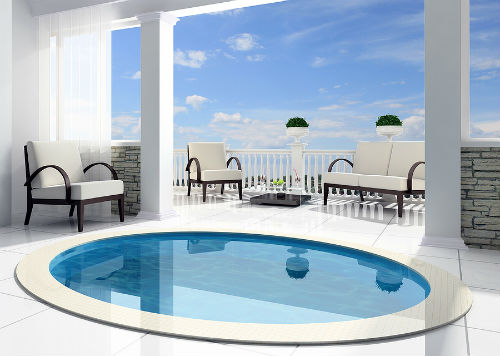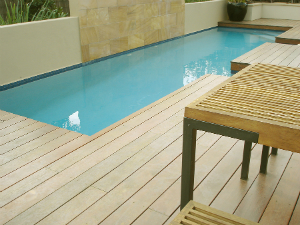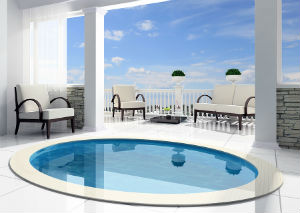Smaller swimming pools are packed with the latest trends and functionality.
By John Storch
With more people living in urban environments and a tendency towards higher-density living, residential outdoor garden spaces are becoming smaller. This desire to fit everything in has put pressure on the amount of space available for swimming pools. The answer is smaller pools.
In addition to residential blocks becoming smaller, council rules are becoming more stringent regarding the amount of space that can be developed on each block. Overall pool costs have risen, the function of pools is changing, there is a trend to use garden spaces as a fusion for indoor and outdoor entertainment, there are environmental considerations regarding water and chemical use, and through educating the public that smaller pools are more functional, smaller pools are coming into their own and becoming much more popular than the standard 4.5m x 9.5m swimming pool of yesterday.
People are beginning to understand that the length or size of the pool is not important for the average family’s backyard. When children are really young, say up to the age of five, they tend to be limited to the pool steps and pool benches on mum’s lap, so the size of the pool is irrelevant. Children aged between five and 12 tend to race each other up and down a pool and play pool games, so the size of the pool may be important at this time. Adults and families with teenage children tend to utilise the benches and seats for relaxing, having a drink and socialising, or simply jumping in the pool to cool off on a hot summer’s day. So a larger-size pool is only really used by children from around five to teenage years.
The function of swimming pools is also changing. There is now a trend to use the garden space as a fusion of indoor and outdoor entertainment, with the swimming pool only one aspect of the area. Other popular inclusions for the outdoor room that may incorporate the pool include a spa, sauna, water features, cabana and other covered areas, barbecues and pizza ovens, daybeds and beautiful exterior furnishings for relaxing and reading, fire pits for night time use and, of course, the traditional paved entertaining area, lawns and gardens.
The more modern pools may be small in size, but can be packed with lots of trends and style and, most of all, functions.
Styles for small pools
There are numerous styles for small pools, including plunge pools, lap pools, courtyard pools, rooftop pools, swim spas with swim jets and oversized spas. Lap pools are installed where an owner is a serious swimmer, and for exercise. Generally, a lap pool should be in increments of standard-recognised lane widths and lengths. Lap pools may also be incorporated as an extended laneway within a standard family pool. Common lengths for domestic lap pools are 12.5m, 15m and 25m. Laneway widths can start at 1m wide. Often, laneways within a pool are separated with floating lane dividers, laneway markings on the pool base or both.
Lane dividers are readily available through local pool shops and pool-bottom laneway markings are usually installed at the time of pool construction in either tiles or paint. Plunge pools are built for entertaining and for cooling off in the summer months; the size is mostly determined by the available space.
Plunge pools can free up the space of external areas for other uses such as informal cricket pitches and football fields in the non-swimming months. I normally consider plunge pools to be from 6m x 3m down to 2m x 3m. Plunge pools are suitable for small regular-shaped spaces such as courtyards and little gardens, where only a small portion of the yard is designated for the pool. Plunge pools are best used for jumping in and cooling off in summer, and often are treated as giant heated spas so teenage children can comfortably sit and entertain in the pool. For entertaining purposes, pool seats and benches are often placed within the plunge pool around all sides. The swimmable length of the pool becomes less important than in a normal or lap pool.
Plunge pools are often the choice for courtyards as they are compact, and often their aesthetic nature is extremely important because they double as beautiful water features. Plunge pools can often incorporate swim jets that allow a swimmer to remain in place while exercising, thereby increasing the functionality of the pool.
Rooftop pools are generally built shallower than normal pools due to engineering constraints and usually incorporate benches and seats. Rooftop pools can be magnificent when executed correctly, with harbour and city views in the background and city fairy lights at night.
Swim spas and oversize spas are frequently prefabricated and in tight, small spaces, they are often the ideal pool solution. There are several reputable companies that specialise in these products and the overall sizes available are similar to plunge pools. There is a good range of sizes and shapes to fit most situations.
A limitation of the swim spa is the depth, which tends to be either 900mm or 1200mm throughout. On the flip side, the beauty of these products is the ease and speed of installation. Being prefabricated, they can effectively be installed in a day and you can be swimming or lounging with bubbly in hand the next!
Design for small pools
Trends for small pools
- There is a current trend towards simplification, possibly as a reflection of global financial constrains. Small pool design is becoming less complicated and is utilising straight, clean lines and monochromatic colours rather than multi-shapes and mixes. People are looking for value and quality, with the best impression created in the finer detail rather than in the size of the project.
- Traditionally, pool depths range from 1000mm through to 1800mm. In smaller pools we often flatten the base and increase the depth of the shallow end to increase the volume of water, allowing total submersion and a cooler plunging summer experience.
- Tiles are often used in small pools as the surface area is reduced from a normal pool, so the cost of using a more expensive finish lessens proportionally.
- The use of good-quality stone for paving, part-filled travertine,
- Himalayan sandstone and local sandstone for paving, along with quality timber surrounds, is increasing in popularity.
- Seats and benches in more traditional pools tend to run along one side. In smaller plunge pools, we like to make them turn the corner to create an entertainment nook.
Functions of small pools
Hints and pitfalls
DETAILS
This article was written by John Storch, principal of A Total Concept Landscape Architects and Swimming Pool Designers. A Total Concept is an established awardwinning practice specialising in the integration of internal and external areas, with beautiful and functional swimming pools, gardens and cabanas for projects ranging from plunge pools for simple family homes to boutique and resort-style developments. A Total Concept provides services which include consultations, designs and specifications, council approvals, builder recommendations and the total management of the project and contract administration.
Website: http://www.atotalconcept.com.au/








